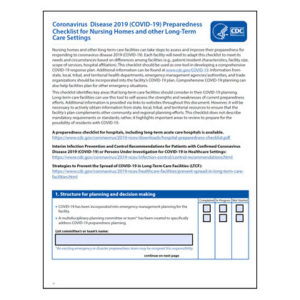COVID-19 and the Elderly: Could MMR Vaccination Slow the Pandemic?

J. Wesson Ashford, M.D., Ph.D.
As of July 25, 2020, there have been over 15 million confirmed cases of COVID-19 in the world and over 600,000 deaths (83 deaths per million). In the United States, there have been over 4 million cases and over 145,000 deaths (441 deaths per million).
COVID-19 has killed more people in the US than any other cause so far in 2020, except for coronary heart disease.
COVID-19 disproportionately strikes congregate living facilities yet largely spares the young
Of great note, it is estimated that about half of all deaths in the U.S. from COVID-19 occur in long-term care facilities (LTCFs), including skilled nursing facilities (SNFs) and assisted living facilities (ALFs), which are largely populated by older individuals with the specific risk factors associated with more severe disease and mortality associated with COVID-19 – cardiovascular disease, diabetes, hypertension, lung disease, and cerebrovascular disease. But even considering these comorbid illnesses, it is unclear why COVID-19 affects the elderly so severely.
By contrast, COVID-19 generally spares the young. Of note, children under one year of age are affected more severely than children between 2 and 18 years of age. Clearly, congregate living environments – including LTCFs, jails, and prisons – are environments that spread COVID-19. But that does not explain why children are so spared.
Some countries do much better than others with COVID
It is also not clear why certain countries have been relatively spared. China, with a population over 1.4 billion, has only reported 138 deaths outside of Hubei Province (population less than 60 million). This low incidence has been widely attributed to China’s stringent control over its population or failure to report its cases.
However, numerous other countries in the Western Pacific Region which also have dramatically few cases, including Taiwan (24 million people, 458 cases, 7 deaths) and Japan (126 million people, under 30,000 cases, 994 deaths). In Africa, there are two countries with very low rates, Madagascar (26 million people, 8,741 cases, 76 deaths) and Uganda (43 million people, 1,089 cases, 1 death).
Meanwhile, six countries in Europe have had more than 400 deaths per million people, led by Belgium (846 deaths per million people) and the United Kingdom (673 deaths per million).
MMR vaccinations could explain geographic disparities
There is an important possible explanation for why there is such difference of COVID-19 mortality rates around the world: the implementation of MMR (measles, mumps, rubella) vaccination programs to control measles.
Since 2005, the WHO Western Pacific Region, with 37 countries and territories, has made a major, successful effort to eliminate measles from this region, and all of these countries and territories have a relatively small number of confirmed COVID-19 cases and few to no deaths.
In particular, China, one of the countries of this region, has achieved a near universal double MMR vaccination rate of 99.5%. The two countries in Africa that have largely been spared from COVID had notable measles outbreaks in the last two years and vaccinated large proportions of their populations.
By contrast, in European countries and the U.S., which have long had measles under relative control, adherence to MMR vaccination recommendations has become problematic. Belgium has a particularly low rate of second MMR vaccination (75%).
There has been a considerable amount of misinformation about the danger of MMR vaccinations, most notably in the U.K., where the vaccination rate fell to 80% in the early 2000s. There have also been numerous publications about “vaccine hesitancy” around Europe and the U.S.
MMR vaccine may confer protection to young children who have recently been vaccinated
Similarly, MMR vaccination can explain why children over the age of 1 to 2 years old are so resistant. The CDC recommends that children get two doses of MMR vaccine, the first at 12 to 15 months of age and the second when kids are between 4 and 6 years old. The MMR vaccine’s long-term benefit does decline with age, and many mothers considering pregnancy have been found to have inadequate immunity to these diseases.
With the age relationship and the international variations, there is substantial evidence that MMR vaccination may protect against COVID-19, reducing both the severity of the illness caused by the virus and its spread.
The vaccine is safe, cost-effective, and widely available
The CDC does not recommend MMR vaccination for people born before 1957 because these diseases were universal before then, and infection with those diseases confers a high degree of lifetime immunity.
However, the current MMR vaccine known as M-M-R II, first introduced in 1979 and still used today, appears to confer special protection against COVID-19. As such, even positive results on an MMR titer test should not preclude someone from getting an MMR vaccination now.
While some have suggested other existing vaccines may protect against COVID-19, we believe this is unlikely as none of these other vaccines have been used in the recent massive MMR re-vaccination campaigns that are directly associated with few (or in some cases, zero) COVID-19 deaths. The rubella virus spike protein in MMR has a 29% commonality with the spike protein of the SARS-CoV-2 virus, which is likely why MMR is cross-reactive with COVID-19.
The CDC recommends MMR vaccination for several groups of individuals, including healthcare personnel without evidence of immunity, women of childbearing age who are considering pregnancy, and people over six months of age who will be traveling internationally.
The CDC notes some individuals should not get the MMR vaccine, including those who may be immunocompromised. However, beyond such considerations, the MMR vaccine is generally considered safe. The CDC specifically says, for example, that the vaccine is safe for women who are breastfeeding.
MMR vaccination program could protect your staff and residents from COVID
The implication of these findings is that MMR vaccination may prevent COVID-19, reduce its severity, and eliminate its spread. It could be prudent and of very low risk for all individuals living and working in congregate care living situations to receive MMR vaccinations.
The MMR vaccine is currently available at pharmacies without prescription and can be easily ordered and provided on-site immediately. Ideally, leadership of such facilities would consider the minimal cost and great potential benefit of MMR vaccination and introduce programs to provide this simple intervention and monitor its effectiveness.

J. Wesson Ashford, M.D., Ph.D. is a clinical professor (affiliated) with Stanford University.
Related Articles
Topics: Administration , Clinical , Departments , Executive Leadership , Featured Articles , Infection control , Leadership , Resident Care










